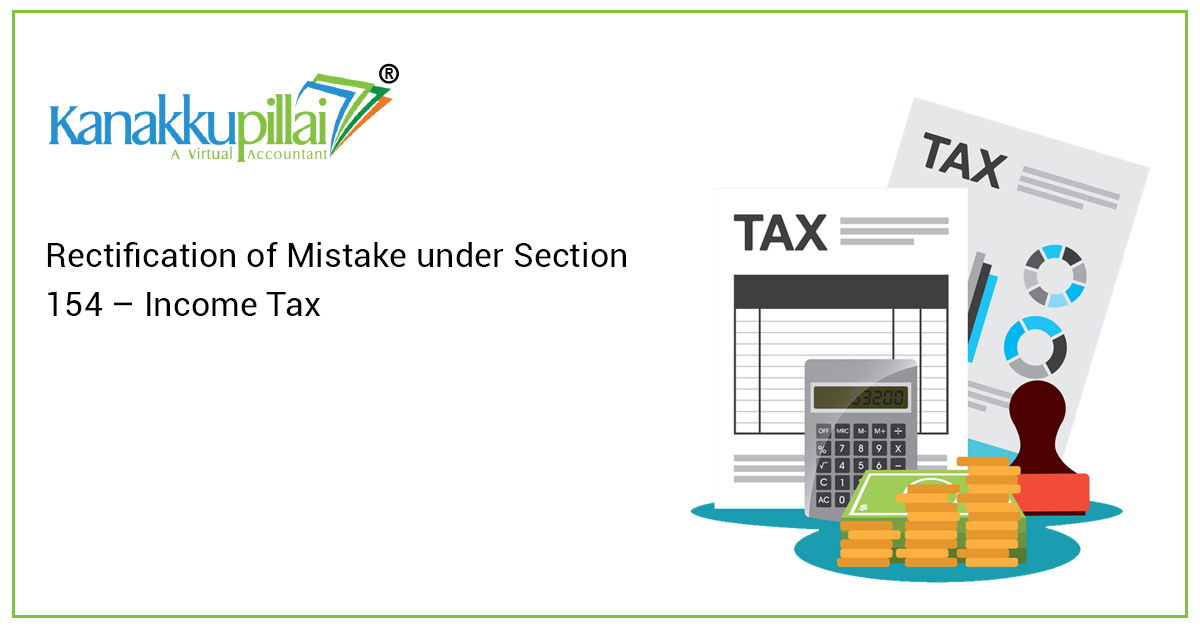During certain times, an order which was issued by the Assessing Officer or the AO may contain an error from time to time. In this case, an error that is found from the record can be corrected or rectified under section 154 of the Income Tax Act.This section discusses the provisions of Section 154 pertaining to the rectification orcorrection of mistakes.
Section 154 can be Used to Rectify an Order.
The respective Income-Tax authority may amend any order issued under any part of the Income-Tax Act in order to rectify or correct any mistake apparent from the record.
- Make amendments to any order that was passed by such authority under the respective provisions of the Income Tax Act.
- Make any necessary changes to any intimation or presumed intimation given under section 143. (1).
- Amend any intimation which was provided to the assessee under section 200A (1), here the section 200A is basically dealing with the processing of TDS returns or tax deducted at source statements.
- Make any necessary or relevant changes to any intimation under section 206CB of the Income Tax Act.
It shall be noted that a TDS statement is processed under section 200A after any arithmetical errors in the statement have been rectified or corrected, as well as any inaccurate claims that are obvious from the statement’s information. Similarly, the Finance Act of 2015 adds a new section, namely 206CB, to provide for the processing of TCS statements or the Tax Collected at Source Statements.
If the taxpayer’s refund or tax liability or burden decreased or increased as a result of the correction of a mistake, the taxpayer is entitled to a hearing or a chance of being heard by the income tax authority.
Rectifying an Order, Subjecting to Appeal or Revision
Any issue that has been taken as the subject matter of any revision or appeal for that matter cannot be remedied through rectification by the AO or the Assessing Officer. In other words, if an order is the subject or the central matter of an appeal, the Assessing Officer or AO can only correct the issues that are not resolved in such an appeal.
Who can Start the Rectification Process?
The income-tax authorities hold the right or the authority to correct the error on their own.
But the taxpayer can notify the income-tax authority of the error by filing an application so as to correct the error which has been caused.
If the Commissioner (Appeals) is the one who issues an order, then such Commissioner (Appeals) can correct any errors formed or made and are the one’s which the Assessing Officer or the taxpayer have brought to his or her attention.
What is the time limit for Rectification?
Four (4) years have passed since the end of the financial year in which the order sought to be rectified was issued, and no order of rectification can be issued. The four (4)-year term begins on the date of the order sought to be corrected, not on the date of the original order. As a result, if an order is changed, set aside, or otherwise modified, the four-year term begins on the date of the new order, not on the date of the original order.
If the taxpayer submits a request for correction, the authority must change the order or refuse to approve the claim within six (6) months of receiving the request.
Describe the Procedure for Submitting an Application for Rectification
The taxpayer should bear the following considerations in mind before filing any rectification or correction application:
- The taxpayer should read the order against which he intends to make the correction or rectification application carefully.
- The taxpayer may believe that there is an error in the order issued by the Income Tax Department, but the taxpayer’s calculations may be incorrect, and the CPC may have corrected these errors. For example, the taxpayer may have computed incorrect interest in the return of income, but the interest may have been computed correctly in the intimation.
- To prevent applying rectification in the above-mentioned instances, the taxpayer should examine the order and establish the existence of the intimation errors, if any.
- Only if he notices a mistake in the order could he file an application for rectification or correction under section 154.
- He should also clarify that the error is one that is obvious and apparent from the records and not one that requires further discussion, explanation, or inquiry. A taxpayer can submit an online application to correct a mistake. The taxpayer should review the correction procedure at https://incometaxindiaefiling.gov.in/ before submitting an online application for rectification as per section 154 of Income Tax Act.
- http://contents.tdscpc.gov.in/en/filing-correction-etutorial.html explains how to file an online correction statement for rectification of intimation under Section 200A (1)/206CB.
- A change or rectification that raises the taxpayer’s (or deductor’s) liability must be made only after the authority involved has given the taxpayer the notice of its intention to do so and provided the taxpayera fair chance to be heard and explain the details.
How Should I Apply for the Rectification?
The procedure for submitting an online correction request underSection 143(1) and Section 154 are the same as for amending an income tax return.
Before filing a rectification request, you should carefully review the order against which you want to make a rectification request. You must double-check the computations and verify that all exemptions and deductions are taken into account. It’s conceivable that your calculations are incorrect, and the tax statement has been corrected by the Centralized Processing Centre in Bengaluru. Compare your income tax return to Form 26AS to verify or double-check the same. If you’re unsure, seek the advice of a tax specialist, and Kanakkupillai will be able to help you with this.
If you still notice a mistake in the tax details after verifying, you can file a correction under Section 154. These errors cannot be due to additions or omissions in the income or investment statements. The Income Tax Act stipulates that the errors for which correction is sought must be “obvious from the records” and should not necessitate any argument or investigation.
You can submit a correction request using the IRS’s e-filing website. Rectifications of intimations under Sections 200A (1) and 206CB will need the submission of an online rectification statement.
FAQs or Frequently Asked Questions
- When submitting a rectification request under Section 154 (1) of the Income Tax Act, what errors can be corrected?
Factual mistakes, mathematical errors, clerical errors, and inadvertently forgetting certain mandatory law elements are all examples of faults that can be corrected in your income tax filings under Section 154.
- Can I file a Section 154 rectification or correction request to modify my address or bank account information?
No, the correction or rectification request provision in Section 154 cannot be used to update your address or bank account information.
- Is it better to make a Section 154 rectification or correction request online or offline?
If you filed your income tax return online, you should also file your Section 154 correction or rectification request online.
- What is the maximum number of justifications for filing rectification or correction requests under Section 154 of the Internal Revenue Code?
When making a correction or rectification request under Section 154, you can choose up to four reasons.
- Should therectification or correction be submitted if there is a change in income when repairing a mistake under Section 154 of the Income Tax Act?
No, if a change in income is discovered when correcting or rectifying a mistake under Section 154 of the Income Tax Act, a revised income tax return, not a rectification, should be filed.





